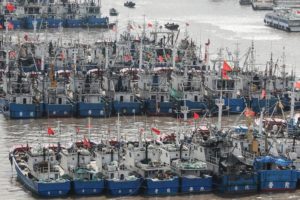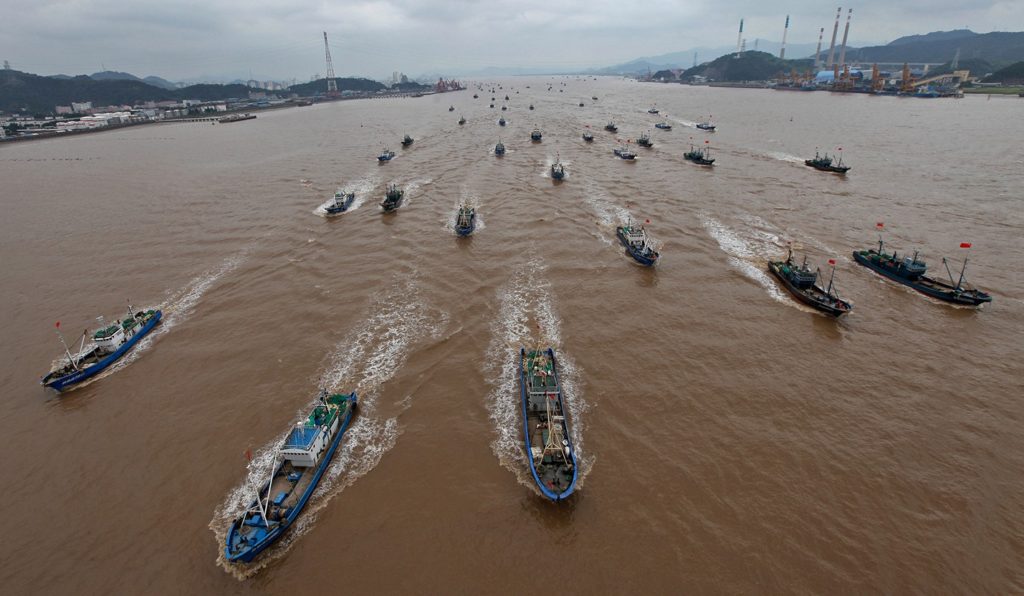 China is militarizing part of its fishing fleet of 200,000 to 800,000 vessels.
China is militarizing part of its fishing fleet of 200,000 to 800,000 vessels.
China’s conventional navy isn’t considered particularly formidable beyond coastal defense. But Beijing has an ace up its sleeve. While well known to U.S. government officials and military planners, China’s huge fishing fleet — and its real purpose — is largely unknown to the American public.
China, seeking to preserve “plausible deniability,” says it’s “just” a fishing fleet. But Western analysts say it’s more than that, and its real purpose is twofold: Power projection, and monopolizing the world’s ocean resources.
On the latter point, China aggressively exploits global fisheries everywhere, but especially in waters near its shores. Chinese fishing fleets hoover up fish, squid, and shellfish with no regard for sustainability or the environment, robbing poor countries of food in the process, and also aggressively engage in territorial infringement and poaching. Read about that here and here.
Americans are used to thinking of fishing boats as commercial vessels manned by civilian fishermen. But much of China’s massive fishing fleet is integrated into its military chain of command, with crews receiving military training, and it can be called upon in peacetime or war for quasi-military and military missions.
China’s military use of fishing vessels is overt in the South China Sea, where China is aggressively asserting sovereignty and trying to drive out vessels and aircraft of other nations, using these assets to conduct so-called “gray” operations, i.e., low-intensity harassment of foreign vessels and aircraft below a level that would provoke a military response — such as shining lasers at pilots and ramming vessels.
In April 2019, a U.S. analyst wrote, “The elite units engaged in these incidents incorporate marine industry workers (e.g., fishermen) directly into China’s armed forces. While retaining day jobs, they are organized and trained … and activated on demand. …. Lacking fishing responsibilities, personnel train for peacetime and wartime contingencies, including with light arms, and deploy regularly to disputed South China Sea features … the PAFMM is a state-organized, -developed, and -controlled force operating under a direct military chain of command to conduct Chinese state-sponsored activities.” The same analyst provided details of the command structure here.
“Many of the fishing boats are not fishing. They’re asserting control,” an Australian news outlet reported. “A different kind of fishing fleet, one engaged in paramilitary work on behalf of the state rather than the commercial enterprise of fishing, has emerged … they engage in patrol, surveillance, resupply, and other missions to bolster China’s presence in contested waters …. Last year, the United States declared it was ‘aware’ China’s fishing fleet was being used to assert territorial control. Then Chief of Naval Operations Admiral John Richards warned these trawlers could be considered naval auxiliaries because of the military nature of their training and operations.”
These military vessels are designed to blend in. Another Australian publication said in July 2020, “Many of these fishing vessels are indistinguishable from China’s ordinary fishing fleet, as they engage in a variety of peacetime missions and receive military training to conduct operations during armed hostilities.” (see story here.) That source added, “Today the most capable units of the PAFMM are prepared to wage a guerilla war style ‘People’s War at Sea,’ armed with sea mines and anti-air artillery and missiles. The ships are also trained to conduct intelligence, surveillance and reconnaissance (ISR) and potentially relay data to facilitate the PLAN kill chain. This distributed network, estimated to be as many as 20,000 vessels and hundreds of thousands of militia constitutes a ‘maritime reconnaissance network’ that complicates force planning for a potential adversary.” Under the San Remo Manual’s non-binding rules of sea warfare, they are legitimate military targets, but would be hard to distinguish from fishing vessels that are protected from military action under the rules.
The Rand Corporation, a U.S. defense-oriented think tank, published an article in April 2020 saying, “China’s armed fishing militia—officially called the People’s Armed Forces Maritime Militia (PAFMM) by the U.S. Department of Defense—plays an instrumental role in Beijing’s strategy to enforce its sovereignty claims in the South China Sea and East China Sea. PAFMM is a government-supported armed fishing force … under the direct command and control of the People’s Liberation Army (PLA) … [which] plays a particularly important role in establishing a de facto Chinese operating presence in disputed areas …. These classic ‘gray zone’ operations are designed to ‘win without fighting’ by overwhelming the adversary with swarms of fishing vessels” with backing from Chinese warships. (Story here.)
Another source said, “The Chinese Maritime Militia is an effective auxiliary mechanism of the Peoples Liberation Army Navy (PLAN). This seagoing naval militia … [is] a grey zone operator. On occasion the militia operates autonomously; alternatively it functions within the command structure of the PLAN. As a grey zone operator the maritime militia will engage in activities that the regular Chinese navy can not. This allows the Chinese regular navy to avoid increased tensions … in contentious maritime environments. The maritime militia is able to conduct activities that could escalate to war …. Activities the maritime militia engages in may be considered irregular or asymmetrical in nature. Actions include; intelligence, surveillance and reconnaissance, sabotage, contested water skirmishes, obstruction, reef/island development, mine laying, concealment missions, spying and ambush.” (Read story here.)
U.S. military planners seem confident they could defeat China in a war. For a description of what strategies might look like, see this article. But some observers feel the U.S. military isn’t sufficiently taking into account China’s paramilitary fishing fleet (see, e.g., this article).
 In 2016, two specialists in 21st century warfare published a fictionalized account of a war in which China seizes Hawaii and destroys the U.S. Navy’s Pacific fleet — a 21st century version of Pearl Harbor — called Ghost Fleet. I’ve read the book and it lays out a chillingly plausible scenario. It being a novel, the “good guys” use the U.S. Navy’s last functioning ship to achieve a status quo ante armistice, but it’s a near thing. This book doesn’t mention, or take into account, China’s “ghost fleet” at all. It’s not hard to imagine it being used in a conflict to wreak havoc on the seas, blockade ports, and conduct thousands of widely-dispersed commando landings. How prepared the U.S. and its allies are to cope with this contingency is an interesting question.
In 2016, two specialists in 21st century warfare published a fictionalized account of a war in which China seizes Hawaii and destroys the U.S. Navy’s Pacific fleet — a 21st century version of Pearl Harbor — called Ghost Fleet. I’ve read the book and it lays out a chillingly plausible scenario. It being a novel, the “good guys” use the U.S. Navy’s last functioning ship to achieve a status quo ante armistice, but it’s a near thing. This book doesn’t mention, or take into account, China’s “ghost fleet” at all. It’s not hard to imagine it being used in a conflict to wreak havoc on the seas, blockade ports, and conduct thousands of widely-dispersed commando landings. How prepared the U.S. and its allies are to cope with this contingency is an interesting question.
Photos: It’s not hard to imagine large fleets of these small boats being used to block port entrances, lay mines, and disrupt shipping lanes.

There are two political responses. One you declare fishing boats doing these gray operations pirates.
Second the US, Australian, Vietnamese, ect governments declare all of China’s fishing vessels legitimate targets in times of conflict and sink some. Yes it makes our fishing vessels targets, but they already are. A nation doing these operations is not going to think twice about sinking other nations fishing vessels.
Formally complain in the UN using the law of the sea, and perhaps our Senate should approve the most recent Sea treaty we wrote and negotiated but are not a part of.
Most of that is already being done.